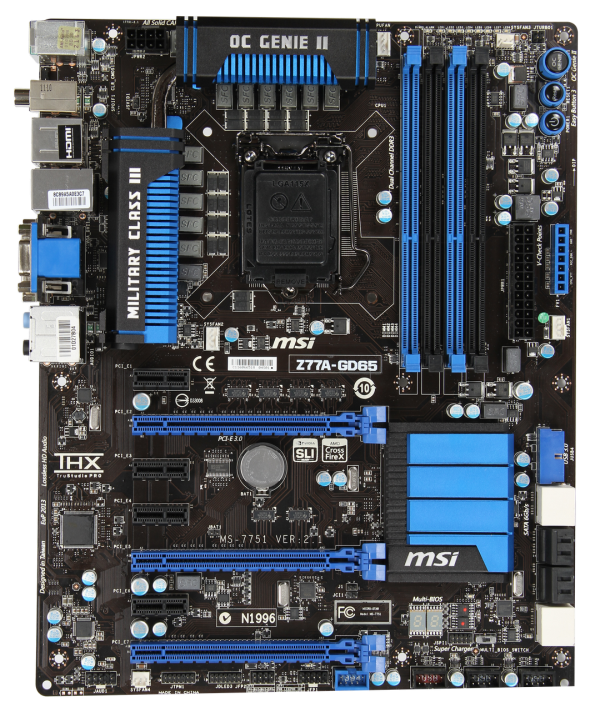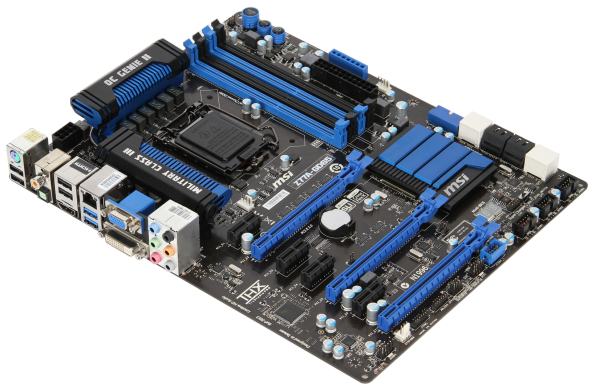Intel Z77 Panther Point Chipset and Motherboard Preview – ASRock, ASUS, Gigabyte, MSI, ECS and Biostar
by Ian Cutress on April 8, 2012 12:00 AM EST- Posted in
- Motherboards
- Intel
- Biostar
- MSI
- Gigabyte
- ASRock
- Asus
- Ivy Bridge
- ECS
- Z77
MSI Z77A-GD65—Visual Inspection
Whenever it comes to a motherboard comparison involving ASUS, Gigabyte or ASRock against an MSI board, the MSI board always tends to show a strong result—either in terms of price, performance or features. So when it comes to the new batch of motherboards for Ivy Bridge, it is fair to say that I expect a strong showing from MSI. For this preview, we have their Z77A-GD65, which will be one behind their future released GD80 that got attention back at CES for being Thunderbolt equipped.
The Z77A-GD65 is another motherboard in this roundup that comes in a black and blue livery. This time MSI have more of an excuse than others do as they have been using it for a fair while now. Using what is essentially a 10 + 2 phase power delivery, MSI are using somewhat beefier heatsinks than their rivals, connecting both via a heatpipe. The socket area is right up against Intel's minimum requirements from left to right, but there is some room to maneuver big air coolers from top to bottom. Around the socket there are at least four fan headers to use: one 4-pin CPU header between the top VRM and the memory slots, a 4-pin system fan header just the other side of the memory slots, a 4-pin to the bottom left of the socket area, and another 4-pin beside the 24-pin ATX power connector. A fifth fan header can be found at the bottom of the board.
Along the right hand side, we have the standard MSI trio of power/reset/OC Genie buttons, followed but a series of voltage checkpoints for overclockers. Aside from the 24-pin power connector and the system fan header, there is also a USB 3.0 header at right angles to the board, indicating its primary use is to the front of the case. Underneath this are the eight SATA ports—two SATA 6 Gbps from the PCH, four SATA 3 Gbps also from the PCH, and another two SATA 6 Gbps from an ASMedia controller.
As the power/reset/OC Genie buttons are at the top right, the bottom of the board has more room to fit in all the headers as needed—front panel audio, TPM, front panel headers and USB 2.0 headers. In terms of PCIe, MSI have done away with the PCIe to PCI bridge and focused purely on PCIe. We have an x1, x16 (x8 with dual GPU), x1, x1, x8, x1, and a PCIe 2.0 x4. In this instance, there is plenty of room for a dual GPU setup with PCIe slots to spare for any extras.
Also of note is the chipset cooler, which is very flat and large with minimal fins, perhaps suggesting that MSI is confident about their heatsink design. Underneath this is a two digit debug display, and a BIOS switch for changing between two BIOSes.
On the rear IO panel, I think MSI have been reasonable with what they have left in and what they have left out. From left to right, we have a combination PS/2 port, two USB 2.0 ports (black), a clear CMOS button, digital and coaxial SPDIF outputs, two more USB 2.0 ports (black), a HDMI port, gigabit Ethernet, two USB 3.0 ports (blue), D-Sub, DVI-D, and audio jacks.
Board Features
| MSI Z77A-GD65 | |
| Size | ATX |
| CPU Interface | LGA-1155 |
| Chipset | Intel Z77 |
| Power Delivery (CPU/iGPU) | 8 + 1 + 2 + 1 (VRM/VTT/GPU/SA) |
| Memory Slots |
Four DDR3 DIMM slots supporting up to 32 GB Up to Dual Channel, 1066-2667 MHz |
| Video Outputs | HDMI, DVI-D, D-Sub |
| Onboard LAN | Intel 82579V |
| Onboard Audio | Realtek ALC898 |
| Expansion Slots |
2 x PCIe x16 Gen3 (x16, x8/8) 1 x PCIe x16 Gen2 (x4) 4 x PCIe x1 Gen2 |
| Onboard SATA/RAID |
2 x SATA 6 Gbps (PCH), Support for RAID 0, 1, 5, 10 4 x SATA 3 Gbps (PCH), Support for RAID 0, 1, 5, 10 2 x SATA 6 Gbps (ASMedia ASM1061) |
| USB |
4 USB 3.0 ports (2 back panel, 2 from headers) 10 USB 2.0 ports (4 back panel, 6 from headers) |
| Onboard |
4 x SATA 6Gbps 4 x SATA 3 Gbps 1 x USB 3.0 Header 3 x USB 2.0 Headers 1 x IEEE1394 Header 1 x TPM Header 1 x Front Panel Audio Header Power/Reset Buttons OC Genie 5 x Fan Headers |
| Power Connectors |
1 x 24-pin ATX connector 1 x 8-pin 12V connector |
| Fan Headers |
1 x CPU Fan Header (4-pin) 4 x SYS Fan Headers (two 4-pin, two 3-pin) |
| IO Panel |
1 x Combo PS/2 Port 1 x Clear CMOS Button 1 x Coaxial S/PDIF Port 1 x Optical S/PDIF Port 4 x USB 2.0 2 x USB 3.0 1 x Gigabit Ethernet Audio Jacks 1 x HDMI 1 x DVI-D 1 x D-Sub |
| Warranty Period | 3 Years |
| Product Page | Link |
It is good to see an Intel NIC on this $180 MSRP motherboard. There are plenty of headers to go around. The only things missing where other motherboards may have better all-round functionality are a PCI slot, mSATA and on-board WiFi.













145 Comments
View All Comments
Iketh - Sunday, April 8, 2012 - link
"handling input in a game engine" means nothing here. What matters is when your input is reflected in a rendered image and displayed on your monitor. That involves the entire package. Lucid basically prevents GPUs from rendering an image that won't get displayed in its entirety, allowing the GPU to begin work on the next image, effectively narrowing the gap from your input to the screen.extide - Tuesday, April 10, 2012 - link
I am sure he knows that. He was just giving a bit of detail as to his exact experience, of which I would bet is far more than most people on here. You have to be very aware of things such as latency and delay when you are handling input in a game engine. I agree with the OP and am skeptical also. The bit that makes me most curious is the transfer of the fully rendered screens from one framebuffer to the other, that has to add some latency, and probably enough to make the entire process worthless. It's not like Lucid has a good track record on stuff like this, I mean we all know how their cross platform SLI/CF took off and worked so well....Iketh - Wednesday, April 11, 2012 - link
Why would you need to physically copy framebuffers?? I'm sure pointers are used...I have no idea if this has tangible benefits, but theoretically it does. None of us know until we can test it. I'm more inclined to discredit the people already discrediting Lucid, despite Lucid's track record. That's what you call hating.
Iketh - Wednesday, April 11, 2012 - link
excuse me, you're right... it has to copy the frame from gpu to igpu... what kind of crap tech is this???ssj3gohan - Sunday, April 8, 2012 - link
Personally, I'm absolutely uninterested in anything 'high-performance', especially fancy gaming stuff. Not to say that I don't think that's a valid market niche, but I see other possibilities.I'm really looking forward to new thin ITX boards with built-in DC-DC converter (i.e. running directly off a 19V brick), and I am especially wondering whether Intel (or Zotac, possibly) is going to build a golden board this time around. Last time, they made DH61AG which was a nice board, but lacked an msata port (kind of a must for a truly thin computer) and 'only' had an H61 chipset.
With H77, I expect it will be possible to make a thin ITX board with USB 3.0 and a fast on-board SSD option, combining this with an HD 4000 equipped processor would enable users to build a truly thin (sub-4 inch thick) computer that fits on the back of their monitor but still provides ample computing power.
Senti - Sunday, April 8, 2012 - link
It sounds to me that Lucid Virtual V-Sync is just glorified triple buffering with a lot of marketing and a bit of overhead for transferring frames and powering two video cards instead of one. I'm very skeptical on the HyperFormance too.Cavalcade - Sunday, April 8, 2012 - link
It seems a bit more involved than triple buffering, more like having 2 buffers where the back buffer is not flipped until it is fully rendered. Seems like this would lead to more stuttering, and given the number of times they asked Mr. Cutress to reiterate that this would be a bug, it may be something they are seriously concerned with.Thinking about it a little more, I'm not sure what advantages this system would have over a system with separated input and rendering modules. The academic side of me is extremely interested and hopeful, but the practical developer side of me is going to require a lot more to be brought on board.
Iketh - Sunday, April 8, 2012 - link
Separate input and rendering modules, as I stated in an earlier post, means nothing. They allow for a responsive mouse cursor, for instance. But, when you actually provide input that alters the RENDERED WORLD, you have to wait for that input to reflect on screen. It doesn't matter how perfectly the software solution is architected, you still have to wait for the rendering of the image after your input.Lucid simply prevents renders that never get displayed in their entirety, allowing the GPU to work on the NEXT image, shortening the time from your input to the screen.
Cavalcade - Monday, April 9, 2012 - link
The comment was to indicate that while I have experience writing input systems, rendering is still relatively new to me; simply a qualifier of my impression and opinion.The way I am understanding Lucid, it is attempting to preempt displaying a frame that is not fully rendered in time for the next screen refresh. By presenting a virtual interface to both the GPU and the application, the application believes the frame has been rendered (displaying user input at that time) and proceeds to render the next frame. Thinking more about it, would this reduce the time interval between input reflected in frame one (which was preempted) and frame two (which will be displayed) so that rather than having input sampled at a fixed rate (say 60Hz) and displayed at a variable rate, input would be more closely tied to the frame for which it is intended.
My interest is rising, but it still seems like a rather complex solution to a problem that I either haven't experienced, or which doesn't really bother me.
Iketh - Tuesday, April 10, 2012 - link
it's not preemtively doing anything, except determining if a frame added to the queue will finish rendering in time... if not, it >>>>DOESNT LET THE GPU RENDER IT<<<< and places the previously rendered image in its place, allowing the GPU to immediately begin work on the FOLLOWING frame... that's it... it cuts unneeded frames from queuesas for your input sampling rate question, that's entirely based on how the application is coded to handle input, lucid has nothing to do with this...